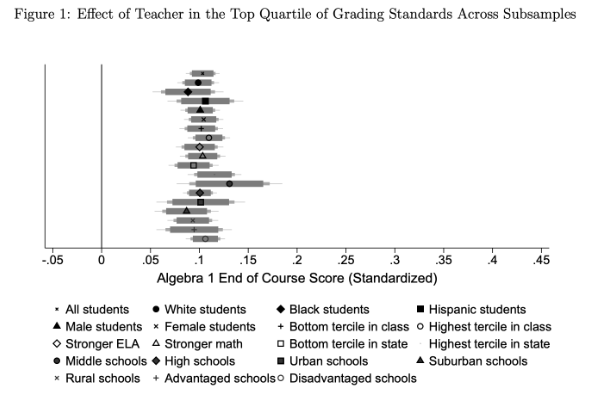Tough Love: Study Shows Kids Benefit from Teachers With High Grading Standards
Research suggests grade inflation has escalated in recent years, but students assigned to tougher graders earn higher math scores.

Get stories like this delivered straight to your inbox. Sign up for The 74 Newsletter
They might not want to hear it, but it’s true: Students assigned to teachers with tougher grading policies are better off in the long run, research suggests.
According to a paper released last fall through Brown University’s Annenberg Institute for School Reform, eighth- and ninth-graders who learned from math teachers with relatively higher performance standards earned better test scores in Algebra I. The same students later saw their improved results carry forward to subsequent years of math instruction, and — contradicting fears that high expectations might cause kids to resist or give up — they were less likely to be absent from classes than similar students assigned to more lax graders.
Seth Gershenson, an economist at American University and one of the paper’s co-authors, said the breadth and longevity of the positive results showed that they were not flowing from a quirk of testing. Rather, high standards “change the way students engage with school,” he argued.

“There really is a persistent, long-lasting sea change that students experience when they have a tougher grader,” Gershenson said. “And it’s not like you have to be super tough; any marginal increase in standards adds a little boost.”
The findings build on earlier work by Gershenson, which showed that pervasive grade inflation in K-12 settings — defined as student course grades that are considerably higher than their corresponding scores on end-of-year exams — is more prevalent in schools serving larger percentages of affluent students. They are also noteworthy in light of the post-COVID academic environment, which has seen many teachers relax their grading policies either through personal initiative or in response to district mandates.
The study is built on grading and testing records for a huge swath of North Carolina students who took Algebra I in either the eighth or ninth grades. In all, the sample included over 365,000 pupils across nearly 27,000 classrooms and 4,415 teachers — a rich enough selection to allow comparisons between thousands of similar students assigned to different Algebra teachers over a 10-year span.
To assess the impact of different standards, Gershenson and his colleagues used multiple measures of grading severity, again relying on the relationship between course grades (over which teachers have wide, though not total, latitude) and performance on end-of-year exams. For example, an Algebra teacher whose students tend to receive higher course grades than their scores would indicate is considered an “easier” grader, and vice versa.
The researchers then sorted the teacher sample into four comparison groups, ranging from the easiest graders to the hardest, and charted the trajectories of their respective students before and after they took Algebra I. Disproportionately, the teachers grouped in the “toughest” quarter were likelier to be white, female, and more experienced than the sample as a whole.
They also tended to achieve more in the classroom.

Across several metrics of academic success, students who were exposed to higher grading standards fared better than their peers. Compared with students who had previously demonstrated similar levels of math performance, those assigned to stricter graders saw larger scoring gains. Notably, those effects were both sizable and linear, meaning that the tighter the grading practices — moving from the easiest-grading quarter to the very hardest — the larger the improvement on test scores.
Students of tougher graders also maintained some of their scoring advantage into the next two classes of North Carolina’s math sequence, geometry and Algebra II. The effects were actually twice as large in Algebra II as they were in geometry, a nuance the authors specifically cited in the paper: Perhaps because of the similarities in content between the two levels of algebra, they theorized, students who were formerly held to higher standards did especially well in the later class, even though the effects should have faded more because of the further passage of time.
“That suggests this wasn’t a pure grade-chasing effect where students crammed more for the test so that they could do better and get the grade they needed,” Gershenson explained. “Instead, it makes me think that there was some real learning that happened and was retained.”
‘Good for everybody’
Though it sets out to measure the benefits of tougher grading policies, the study jibes somewhat with research investigating the inverse phenomenon of grade inflation. According to the High School Transcript Study, a long-term analysis of student grades conducted by the U.S. Department of Education, the average high school GPA rose from 3.00 in 2009 to 3.11 in 2019. But performance on the National Assessment of Educational Progress, referred to as the Nation’s Report Card, stayed flat over the same period.
That federal assessment generated some attention when it appeared last spring, but it only covered the years before the pandemic. Another report, released by the testing group ACT, found evidence of significant grade inflation over 2020 and 2021, with self-reported student GPAs climbing even as ACT scores themselves did not.
Not all education policy scholars are concerned about these revelations. Zachary Bleemer, a professor of economics at the Yale School of Management, has argued that some grade inflation — whether at the university or K-12 levels — can correct inequalities in which student groups pursue intellectually rigorous subjects. (Female college students, in particular, have been shown to discontinue studies in economics if their initial grades are poor.) What’s more, ACT’s hypothesis could rightly be viewed with caution, given the organization’s potential interest in casting high school grades as less reliable than scores on college admissions tests.
But it is also broadly reflected in accounts given by teachers themselves, who have sometimes spoken openly about softening their approach to grading as a response to COVID’s disruption to in-person learning. In big districts like Los Angeles, San Diego, and Clark County, Nevada (home to Las Vegas), new standards have deemphasized deadlines and classroom behavior, giving students more time and chances to complete graded work.
Education authorities have justified those changes as an equity-minded strategy to keep students engaged who might otherwise become frustrated or fall behind in their studies. But Gershenson and his co-authors found no evidence that North Carolina students assigned to harder graders became alienated from school. In fact, those students were slightly less likely than their peers to rack up unexcused absences.
Best of all, whether measured by attendance or test scores, the results of higher standards were broadly similar for a range of different students. While higher-performing math students enjoyed marginally larger gains than their relatively lower-performing classmates, effects were ultimately beneficial across 20 different student categories — each differing by race, sex, class rank, and prior achievement level in math.
Gershenson, who sees grade inflation as a significant problem that distorts how scholastic performance is interpreted, said the near-uniformity of his team’s findings was a strong signal that high standards are “good for everybody.”
“For none of these outcomes… is the effect negative. Sure, the effects are smaller for some groups than others, and they’re smaller for some outcomes than others. But on no dimension are students being harmed by higher grading standards.”
Get stories like these delivered straight to your inbox. Sign up for The 74 Newsletter

;)
